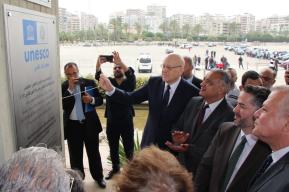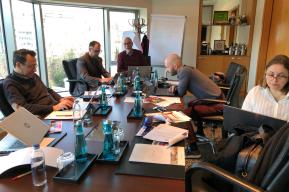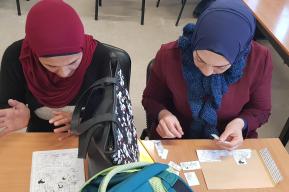Carrying out a precise documentation - down to the millimeter - of the destruction of Beirut’s cultural and architectural heritage after the double explosion of the 4th of August, 2020: this is the colossal bet launched by UNESCO to come to the rescue of the city and its historic buildings, many of which date back to the days of the French Mandate and Ottoman times. Financed by the UNESCO Heritage Emergency Fund (HEF), the documentation project launched in September 2020 was carried out by the French start-up ICONEM, in close partnership with the General Directorate of Antiquities (DGA) in Lebanon, and as part of UNESCO's flagship action plan, Li Beirut. An emergency documentation which should lead to the realization of a three-dimensional geo-referenced model of the Lebanese capital, and which would be crucial on many levels in the process of rebuilding the capital.
"Making a 3D model is like creating a digital twin of reality, with all the textures and damage," explains Joe Kallas, architect restorer specializing in 3D documentation of monuments and historic sites, and in charge of the project with ICONEM. This model will preserve the city in its current situation in case further damage occurs, since the reconstruction process will be quite slow. It also facilitates all assessments and structural analysis reports for architects when they approach the reconstruction works at a later stage. In fact, this documentation speeds up all operations."
To complete this tedious project, it took over an hour to record each GPS point and obtain precise measurements. "We are carrying out an urban-scale documentation of the entire damaged city, from the port to Medawar, Gemmayzé and Mar Mikhaël, over an area of more than 3 square km, explains a member of the DGA team. We also note in detail specific monuments such as the Sursock Palace or the Bustros Palace, which have suffered greatly. We are currently finalizing this work, before getting down to the data processing for the realization of the 3D model, all for a period of 4 months. We have been delayed by the lockdowns, and the scale of the destruction makes the process even more difficult. Not to mention that the streets are very narrow, sometimes with a tangle of obstacles, trees and electric wires". To cope with this tricky situation and to obtain more precise data, the team in charge had to resort, in addition to ground capture, to innovative technologies and drone flights, sometimes reaching an altitude of 150 meters. 60,000 images have been taken so far, reveals Joe Kallas.

An exchange of expertise
In addition to documentation, the project was also an opportunity to train young archaeologists from the DGA in this perilous exercise. "We are improving the techniques of our team through this exchange of expertise, says Dr. Sarkis Khoury, General Director of the DGA. Technology is part of our business, and we need good documentation for all operations. We had indeed started the combing after the explosion with various parties, but this project developed with UNESCO will allow us to obtain this 3D model, to which we will give access to any entity that could use it for the reconstruction of Beirut. Many institutions including large universities have already expressed a desire to use this model."
In this context, Dr. Khoury explains that 3 phases were laid out after August 4th. First, the stabilization, propping and sheltering works with critical structural intervention, then buildings restoration, and finally the interior works and works of art. "I can say that phase 1 has been completed successfully and better than expected, says Dr. Khoury, thanks to the collaboration of all parties including UNESCO, volunteer engineers and civil society. The HEF documentation project was also used for emergency stabilization work." According to UNESCO, the model will also help to integrate projects relating to the revival of cultural life, and the safeguarding of intangible cultural heritage, key components for the resumption of social and economic life in damaged neighborhoods. "Even more, it will be crucial to the restoration interventions of phase 2 of the built and urban heritage in phase 2, which has unfortunately not received significant aid contributions so far, adds Dr. Khoury. Our initial damage estimates were $ 300 million. This amount is now reduced with the completion of phase 1 but we still need a lot of help. "

Asked if he ever imagined tackling a project of such magnitude, Sarkis Khoury has a lump in his throat:
A call echoed by Joe Kallas, who underlines that the restoration will be slow and will depend on funding: “Today we know at least that the stabilization work has been done and that the buildings will hold up in the meantime. But I know how much we have suffered in the past to classify this heritage and preserve it from being destroyed. This area was, somehow, Beirut's last untouched bastion. If we don't want to end up living in a ghost city, every Lebanese must help rebuild the buildings of Beirut, each in his own way. For our city, its historical fabric, its heritage. Today, that is all that's left of it."
Li Beirut is an international fundraising appeal launched from Beirut by the Director-General of UNESCO in the aftermath of the explosions, on August 27, 2020, to support the rehabilitation of schools, historic heritage buildings, museums, galleries and the creative industry, all of which suffered significant damage in the deadly explosions.









